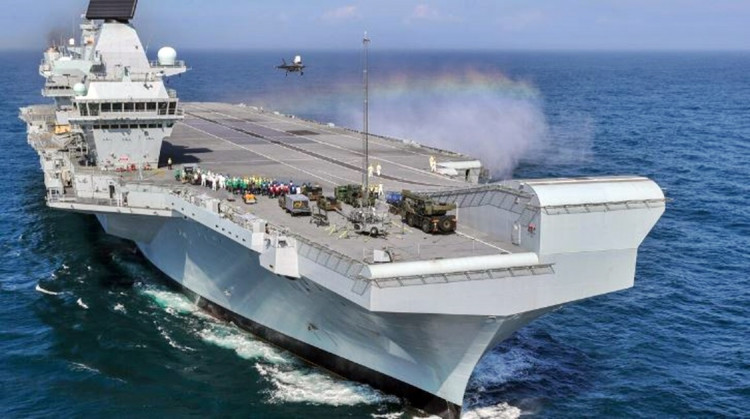The British aircraft carrier HMS Queen Elizabeth will deploy to the Asia-Pacific as originally planned, the Royal Navy says.
The navy said the attainment of initial operating capability of the Queen Elizabeth's carrier strike group made this possible. The 65,000-ton carrier, its carrier air wing and escort ships are ready to deploy within five days.
The supercarrier's air wing includes 36 Grumman F-35B short takeoff/vertical landing stealth fighters and four helicopters. Its surface escort includes guided-missile destroyers, frigates, submarines and supply ships.
For the carrier's first deployment set for March, however, the group includes four Type 45 destroyers and Type 23 frigates.
It will also include a nuclear submarine, a combined fleet stores ship and a tanker. The air wing includes 14 stealth jets and nine antisubmarine helicopters.
Group commander Commodore Steve Moorehouse said the deployment will be the navy's largest peacetime task group in 25 years. It proves Britain's commitment to maintaining world security, or "a visible demonstration of global Britain."
"In practical terms, my strike group is now at very high readiness, meaning we are at five days' notice to deploy, if required, in response to global events and in defense of British interests," Moorehouse said.
In February 2019, the navy announced its plan to patrol the disputed South China Sea alongside the U.S. Navy. Technical and operational delays, as well as the COVID pandemic, led to timetable being set back a year.
In 2019 then British Secretary of State for Defense Gavin Williamson confirmed the Queen Elizabeth would sail to the South China Sea. He said the UK was the second largest investor in the region and it must display "hard power" and "lethality."
"Significantly British and American F-35s will be embedded in the carrier's air wing enhancing the reach and lethality of our forces and reinforcing the fact that the U.S. remains the very closest of partners," Williamson said.
China claims almost all of the South China Sea and its important shipping lanes and potential resources such as oil.
"The U.S. can only concentrate on so many things at once," Williamson said. "The U.S. is looking for other countries to do more. This is a great opportunity for the U.K. and Australia to do more, to exercise leadership."
Since 2017, British defense officials have been saying the carrier's first deployment will be to the Asia-Pacific, and that its voyage from Britain would likely take it through the 3.3 million square kilometer South China Sea.
"The UK is a global power with truly global interests...we must be prepared to compete for our interests and our values far, far from home," Williamson said in 2019.
China reacted to the announcement saying it will "take necessary measures to protect national sovereignty, security and its developmental interests, as well as safeguard peace and stability in the region."






